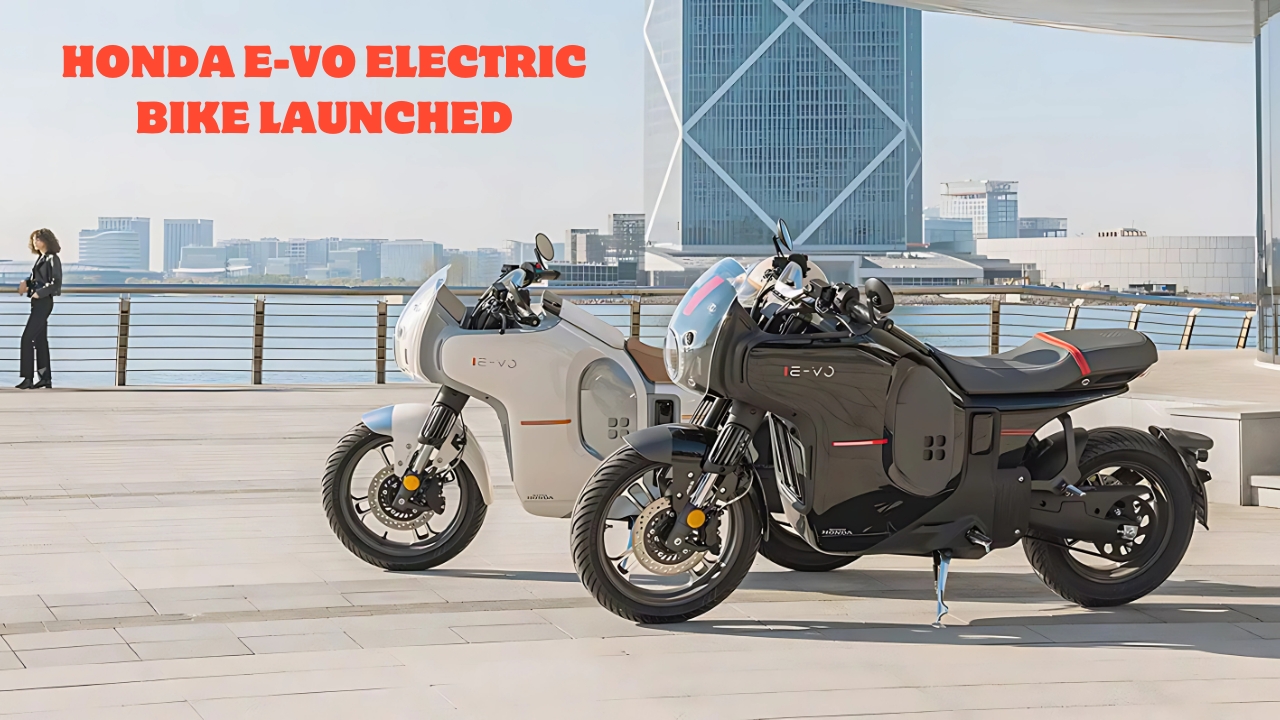The motorcycle world recently witnessed something remarkable when Honda unveiled the E-VO, a sleek electric café racer that caught enthusiasts’ attention worldwide. Yet here’s the twist that reveals everything about Honda’s current global strategy: while this cutting-edge electric motorcycle charges through Chinese streets, American riders can only watch from the sidelines. This isn’t just about one motorcycle—it’s a window into how Honda is fundamentally reshaping its approach to electrification, with China getting the VIP treatment while the U.S. gets left behind.
Understanding the E-VO Phenomenon
Let’s start by examining exactly what the Honda E-VO represents. The E-VO blends classic café racer styling with electric performance, featuring an 8 kW motor capable of reaching up to 120 km/h, with two battery options (4.1 kWh and 6.2 kWh). Think of it as Honda’s answer to the question: “What would a modern electric motorcycle look like if we took the best of vintage design and married it to tomorrow’s technology?”
The bike itself tells an interesting story about innovation. The E-VO carries three batteries onboard which translates to a claimed range of 170 km on a single charge, and it’s the world’s first electric bike to be available with a dashcam. Picture this: a motorcycle that not only runs silently on electricity but also records your journey like a modern smartphone on wheels.
However, here’s where the story gets complicated. This motorcycle isn’t even a Honda in the traditional sense—it’s labeled as “Wuyang Honda” with the first word obviously printed much smaller in the logo to obscure it in favor of Honda’s much stronger brand reputation. This detail reveals something crucial about Honda’s China strategy that we need to understand.
The China-First Strategy Explained
To grasp why Honda is prioritizing China, we need to understand the fundamental differences between the Chinese and American electric vehicle markets. China has become what industry experts call an “EV laboratory”—a place where electric vehicle technology advances at breakneck speed and consumer adoption happens faster than anywhere else in the world.
Honda will introduce a total of 10 Honda-brand EV models by 2027 and make EVs represent 100% of automobile sales in China by 2035. Compare this to Honda’s recently revised global targets, and the contrast becomes stark. Honda has slashed its planned investment in electrification and software by 30% to 7 trillion yen ($48.4 billion) and dropped a target for EV sales to account for 30% of its sales by the 2030 financial year.
Why such a dramatic difference? The answer lies in understanding market dynamics. China’s electric vehicle market has reached a tipping point that the U.S. simply hasn’t achieved yet. EV sales are expected to reach 12 million units in China by 2025 – surpassing ICE vehicle sales for the first time. This means Chinese consumers are actively choosing electric over gasoline vehicles, creating a natural demand that makes aggressive EV investment profitable.
The Technology Partnership Advantage
Honda’s China strategy also benefits from something the company can’t easily replicate in other markets: strategic technology partnerships with local innovators. In China, where electrification and application of intelligent technologies are proceeding faster than other regions, Honda will work with Momenta Global Limited, a Chinese startup company developing autonomous driving technology, to develop next-generation ADAS optimized for road conditions.
Think of this approach like learning a new language by immersing yourself in a country where everyone speaks it fluently. Honda isn’t just selling products in China—it’s learning from Chinese companies that have become world leaders in electric vehicle technology, battery management, and smart car features.
This partnership approach extends to manufacturing as well. The E-VO motorcycle, for instance, is produced through Honda’s joint venture with Wuyang, a Chinese manufacturer that understands local market preferences and production efficiencies. This allows Honda to move quickly and adapt to Chinese consumer demands without the bureaucratic delays that might occur when trying to coordinate between Japan, the U.S., and China.
America’s Hybrid Hesitation
Meanwhile, Honda’s U.S. strategy tells a completely different story. The automaker is aiming to sell 2.2 million to 2.3 million hybrid vehicles by 2030, a huge jump from 868,000 sold last year. Rather than diving headfirst into electric vehicles, Honda is betting that American consumers will prefer the gradual transition that hybrids represent.
This strategy isn’t necessarily wrong—it’s just fundamentally different. American consumers face different challenges than their Chinese counterparts. Charging infrastructure in the U.S. remains inconsistent, especially outside major metropolitan areas. Long-distance travel is more common in America due to geographic differences, making range anxiety a legitimate concern for many potential EV buyers.
Honda and GM had planned to work together on a line of affordable EVs, but those plans have been cancelled. Honda plans to address affordable EVs at an undetermined point in the future, but it will be done in-house and awaits lower-cost technology, such as solid-state batteries. This reveals Honda’s belief that the American market isn’t ready for mass-market electric vehicles at price points that make business sense.
The Competitive Landscape Reality
Honda’s different regional strategies also reflect the competitive realities each market presents. In China, Honda faces intense competition from domestic manufacturers like BYD, which have become global leaders in electric vehicle technology. Honda, like many other legacy automakers, is facing intensifying competition from Chinese firms such as BYD, which sold 3.83 million passenger cars in 2024, all of which were either battery electric vehicles (BEVs) or plug-in hybrids (PHEVs).
This competition actually benefits Honda in an unexpected way. When you’re competing against the world’s most advanced electric vehicle manufacturers, you’re forced to innovate rapidly or lose market share. This pushes Honda to develop better electric vehicle technology faster than they might in a less competitive environment.
In the American market, Honda faces different competitive pressures. Tesla dominates the premium electric vehicle segment, while traditional automakers are still figuring out their electric vehicle strategies. This gives Honda more time to develop its approach, but it also means less urgency to innovate rapidly.
Manufacturing and Supply Chain Considerations
The decision to prioritize China also makes sense from a manufacturing and supply chain perspective. Honda’s total production capacity in China will shrink from 1.49 million units to around 960,000 as the company shifts from internal combustion engine production to electric vehicle manufacturing.
This restructuring represents a massive strategic pivot. Honda is essentially rebuilding its Chinese operations from the ground up to focus on electric vehicles, while maintaining more traditional manufacturing approaches in other markets. This allows the company to experiment with new production techniques and supply chain innovations in China without disrupting their established operations elsewhere.
The E-VO motorcycle exemplifies this approach. By producing it exclusively in China through the Wuyang partnership, Honda can test electric motorcycle technology and manufacturing processes without committing to global production infrastructure. If the motorcycle succeeds, Honda can apply lessons learned to future electric vehicle projects worldwide.
Regulatory and Policy Drivers
Government policies also play a crucial role in shaping Honda’s regional strategies. China has implemented aggressive policies to promote electric vehicle adoption, including subsidies for manufacturers and consumers, restrictions on internal combustion engine vehicles in certain cities, and requirements for automakers to produce minimum percentages of electric vehicles.
These policies create a business environment where electric vehicle investment becomes not just profitable but necessary for survival. Companies that don’t adapt quickly risk losing access to the world’s largest automotive market.
American policies, while supportive of electric vehicles, are generally less aggressive and more focused on incentives rather than requirements. This creates a different business environment where companies can take a more gradual approach to electrification without facing immediate market penalties.
The Technology Transfer Question
Honda’s China-first approach raises interesting questions about technology transfer and global strategy. Innovations developed for the Chinese market, like the advanced features in the E-VO or the smart driving systems Honda is developing with Chinese partners, could eventually benefit Honda’s global product lineup.
However, this process isn’t automatic. Different markets have different regulatory requirements, consumer preferences, and competitive dynamics. A motorcycle designed for Chinese urban environments might not work as well on American highways or European country roads without significant modifications.
Looking Forward: Implications for Honda’s Global Strategy
Honda’s decision to prioritize China for electric vehicle innovation while maintaining a more conservative approach in the U.S. reflects a broader strategic evolution. The company is essentially using China as a testing ground for electric vehicle technology and business models that could eventually be adapted for other markets.
This approach has both advantages and risks. On the positive side, it allows Honda to stay competitive in the world’s largest and most advanced electric vehicle market while learning from the most innovative companies in the industry. The company can develop cutting-edge technology and manufacturing capabilities without committing to global infrastructure investments before market demand justifies them.
However, this strategy also carries risks. American and European consumers might become accustomed to electric vehicles from other manufacturers while Honda focuses on hybrids and gradual transitions. If electric vehicle adoption accelerates faster than Honda expects in these markets, the company could find itself playing catch-up with competitors who made earlier commitments to electrification.
A Tale of Two Markets
The Honda E-VO story illustrates a fundamental truth about today’s global automotive industry: one size doesn’t fit all markets. Honda’s strategy of aggressive electric vehicle development in China while maintaining a more conservative approach in the U.S. reflects the company’s reading of different market conditions, competitive environments, and consumer preferences.
Whether this strategy will prove successful remains to be seen. What’s clear is that Honda is betting on a future where different regions adopt electric vehicles at different speeds and in different ways. The E-VO charging through Chinese cities while American riders wait represents more than just regional product availability—it’s a symbol of how the global transition to electric mobility is happening unevenly across the world.
For now, Chinese consumers get to experience Honda’s vision of electric mobility’s future, while American consumers get a more familiar path through hybrid technology. Only time will tell whether Honda’s dual approach proves prescient or whether the company will need to accelerate its American electric vehicle timeline to keep pace with changing market dynamics.

